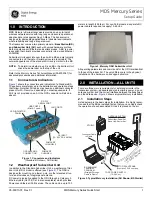
3rd
1
After power on, light 1,2,3 turn green, light 6 turns blue and light 8 turns red.
2
After 1 second, light 1,2,3,6 start flashing. And light 5 and 8 are normally on.
3
After a few seconds, the start is complete. Light 1(Green), 2(Green), 3(Green), 5(Green), 6(blue),
4(Red), 8(Red) are normally on. Light 7 will fast blink.
Remark
:
Light1, 2, 3 are indicator for signal strength.
4
Light 1 on: Signal Weak
5
Light 1,2 on: Signal Normal
6
Light 1,2,3 on: Signal Strong
7
When green light 1,2,3 repeatedly flash in sequence: No connection. The connection between TX
and RX is failed
III. Precautions for integration
1. Be sure to use the parts provided by SUNTOR.
2. Install the antenna before power on to avoid damage to circuits.
3. Given that the carbon fiber body and metal load may have shielding effects on antenna signals, they
should not be installed between the antenna and ground terminal. Keep the antenna of the on board
terminal free from winding or blocking by obstacles. The antenna end should be vertically downward
without bending, to prevent shortening of the communication distance and failure in communication
as a result of blocking.
4. The antennas of the onboard terminal should be separated from each other to achieve good
anti-jamming effects. It should be kept far away from antennas of other onboard radio transmitters, as
huge electromagnetic noise and interference may be caused between various radio antennas, which
will seriously shorten the communication distance, reduce the reliability of communication and even
cause failure in communication. It is recommended to use the functions of SUNTOR product, i.e. image
transmission and RS232 two-way serial port communication to minimize the quantity of onboard radio
devices.
5. Use the antenna of specified type, and properly install it. It is prohibited to use antennas of other
types.
6. Do not disassemble or modify SUNTOR ST5/10/20NPT. Any problem during installation, contact
SUNTOR or the sales agent.
7. Keep appropriate distances between electronic devices during installation to minimize electromagnetic
interference.






























